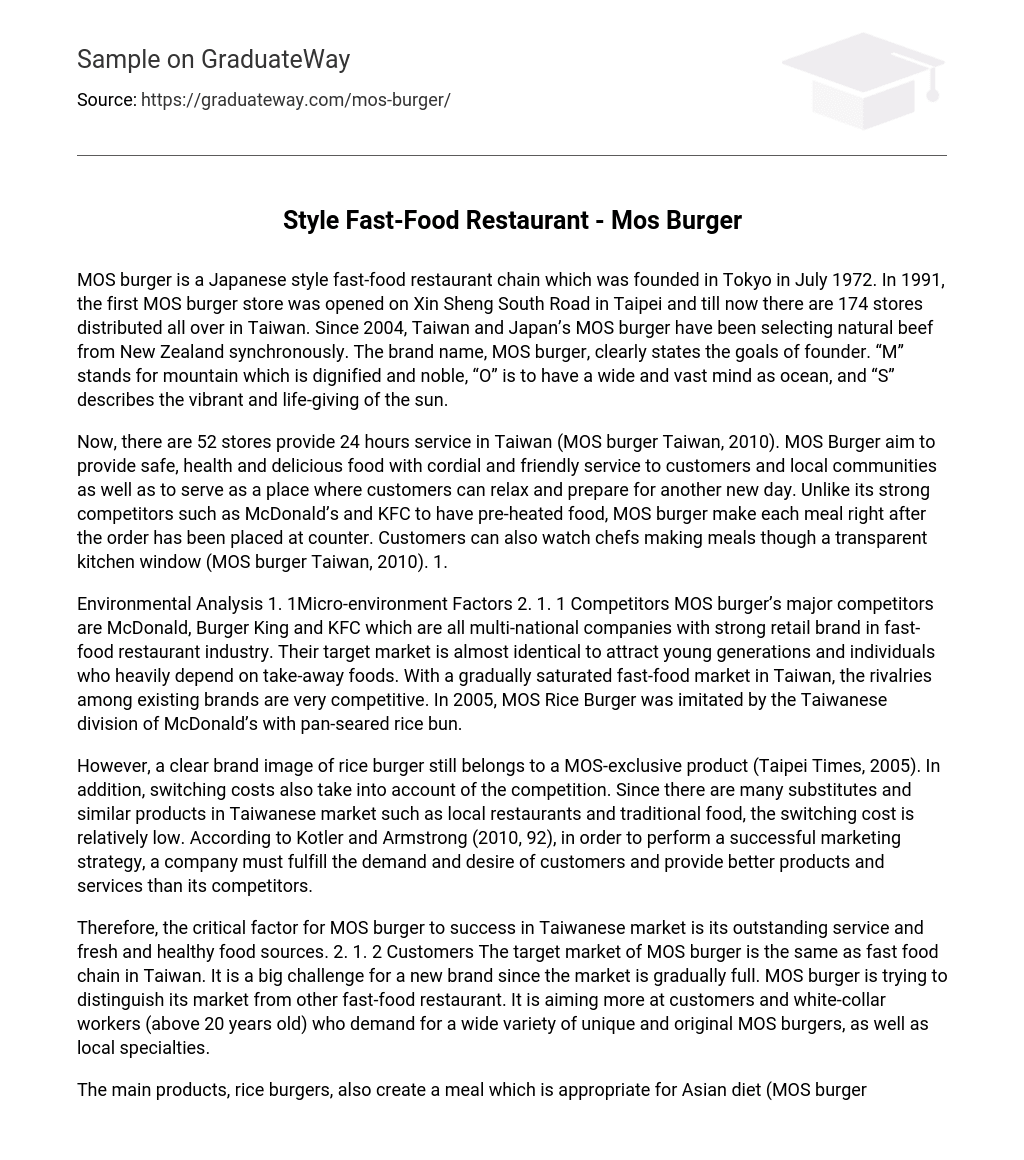MOS burger is a Japanese-style fast-food restaurant chain that began in Tokyo in July 1972. The first MOS burger store in Taipei opened on Xin Sheng South Road in 1991 and there are currently 174 stores throughout Taiwan. Starting in 2004, both MOS burger in Taiwan and Japan have been sourcing natural beef from New Zealand. The name MOS burger reflects the founder’s aspirations: “M” signifies the dignity and nobility of mountains, “O” represents having a broad and expansive mindset like the ocean, while “S” captures the vibrancy and life-giving qualities of the sun.
According to MOS burger Taiwan (2010), there are currently 52 stores in Taiwan that provide 24-hour service. MOS Burger’s goal is to offer safe, healthy, and tasty food along with friendly service to both customers and the local community. Additionally, MOS Burger aims to create a relaxing environment where customers can prepare themselves for a new day. Unlike their strong competitors like McDonald’s and KFC, MOS Burger prepares each meal after the customer places their order at the counter. Customers even have the opportunity to observe the chefs as they make their meals through a transparent kitchen window.
Environmental Analysis 1.1 Micro-environment Factors
2.1.1 Competitors
MOS burger faces tough competition from multinational companies McDonald, Burger King, and KFC in the fast-food restaurant industry. These competitors have a strong retail brand and target the same market segment as MOS burger, which includes young generations and individuals who rely on take-away food. The fast-food market in Taiwan is becoming increasingly saturated, leading to intense rivalries among existing brands. In 2005, McDonald’s Taiwan division copied MOS Rice Burger by introducing a pan-seared rice bun.
However, the Taipei Times (2005) states that a distinct brand image of the rice burger still belongs exclusively to MOS. Moreover, the switching costs are also influenced by competition. Given the presence of numerous substitute products and similar offerings in the Taiwanese market, such as local restaurants and traditional food, the switching cost remains relatively low. According to Kotler and Armstrong (2010, 92), a successful marketing strategy entails meeting customer demands and desires while delivering superior products and services compared to competitors.
Therefore, the key to success for MOS burger in the Taiwanese market is its exceptional service and fresh, healthy food sources. Moreover, the target market of MOS burger in Taiwan is similar to that of other fast food chains. However, MOS burger aims to differentiate itself from other fast-food restaurants by targeting customers and white-collar workers above the age of 20 who seek a wide selection of unique and original MOS burgers, along with local specialties.
The main products of MOS burger Taiwan are rice burgers, which are suitable for the Asian diet (MOS burger Taiwan, 2010). However, customers have low bargaining power in this industry. According to Porter (2008, p. 86), when a product constitutes a significant portion of the buyer’s cost, buyers pay more attention to price and become price-sensitive. In the case of MOS burger, although customers do not spend a large portion of their income on daily meals, they are not highly price-sensitive. Therefore, customers do not have a significant impact on pricing.
Suppliers also impact industry profitability if they have power. They can threaten to charge higher prices, limit quality or services, or shift costs to industry participants (May Porter’s forces, 2005, p.58). However, suppliers only have strong bargaining power when there are few substitutes or rare technologies available in the market. Since MOS burger has strict quality requirements for its products and services, it sources organic food directly from various contracted local farms.
Furthermore, the beef is selected and imported from New Zealand, where all cattle are fed natural grass and do not receive growth hormone injections. As a result, local suppliers have limited bargaining power.
2.2 Macro-environment Factors 2.2.1 Demographic environment factors
Taiwan, as a newly industrializing society with one of the highest economic growth rates globally, has experienced significant changes in family structure in recent decades (Appendix 1). For example, the extended family type has shifted to the nuclear family.
Women in households with two incomes often have limited time to cook meals, leading them to choose fast food restaurants for dining out (Hu, 2002). Additionally, the Taiwanese society has experienced a transition from agriculture to a service-based economy, resulting in a significant increase in average annual income. Therefore, marketers should consider income distribution and average income, as affluent consumers are willing to purchase luxury items (Kotler and Armstrong, 2010, 104).
With the growth of the economy, the average income for Taiwanese individuals has risen from under $500 before the 1970s to over $13,000 since the mid-1990s. This income is now the third highest in Asia (Yi and Wu, 2001). Additionally, the increasing number of young people taking on part-time jobs has bolstered consumer spending capabilities. In terms of cultural factors, the Taiwanese market has seen a proliferation of fast-food restaurants and a shift in dietary habits. More Taiwanese individuals now have their three daily meals outside of their homes.
A study conducted by the Directorate General of Budget, Accounting and Statistics, Executive Yuan, R. O. C. (2010) discovered that 93% of Taiwanese individuals regularly eat at restaurants. In addition, about 33.74% of people dine out more than four days a week. The research also indicated a 20% increase in family dining out rates over the past twenty years. This suggests that the growing number of fast-food establishments aligns with the evolving eating habits of Taiwanese individuals.





